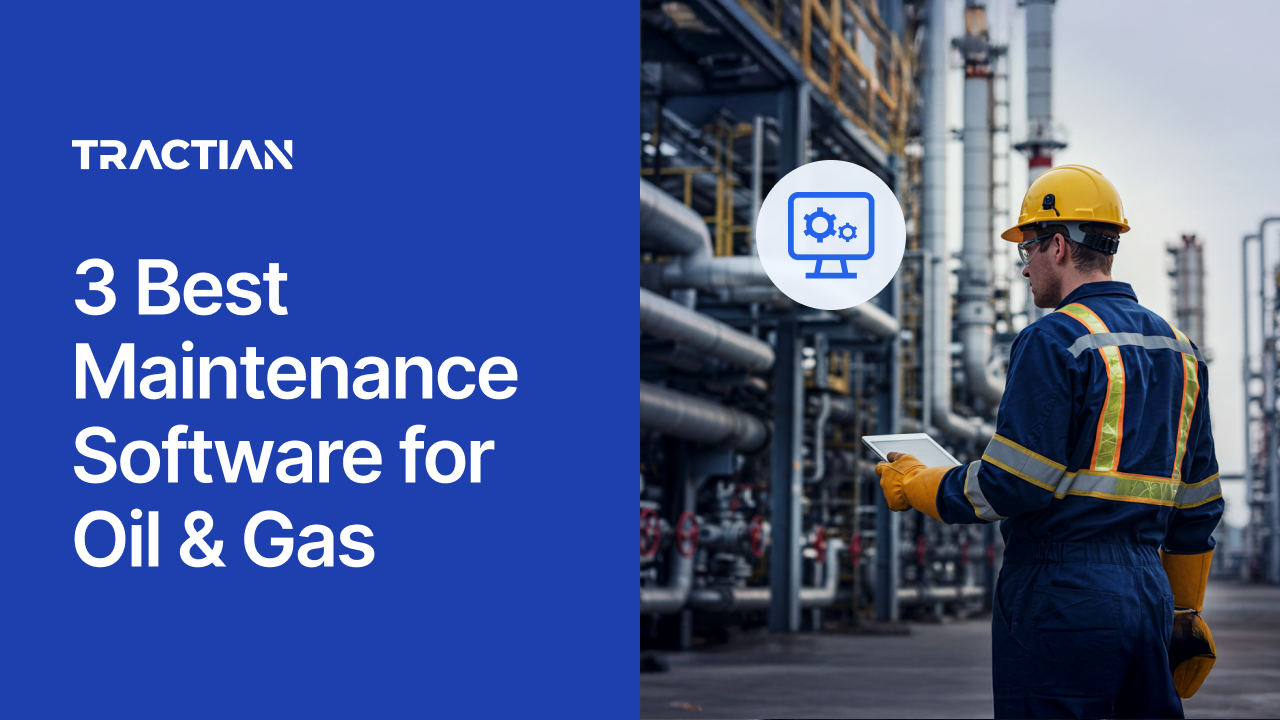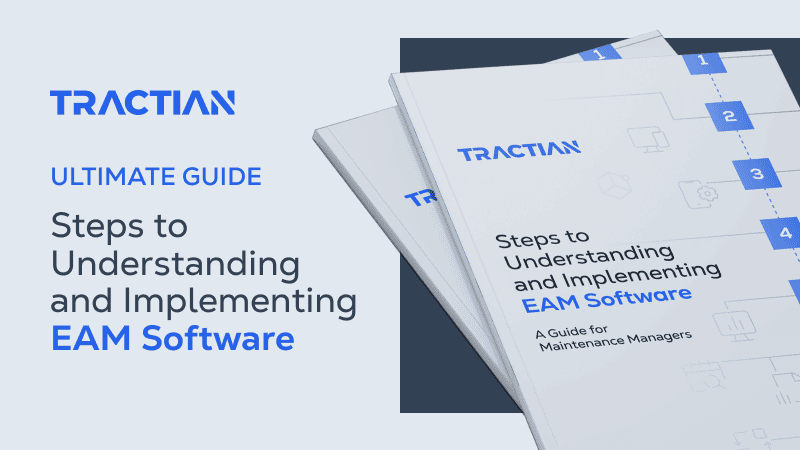If you work in the oil and gas industry, you know downtime can disrupt your entire operation. The right oil and gas maintenance software or CMMS for oil and gas can help prevent failures, reduce costly shutdowns, and protect the value chain.
One failed pump offshore, one unexpected shutdown at a compressor station, and you’re not just dealing with deferred output, but facing missed quotas, supply chain penalties, safety investigations, and seven-figure losses by the hour.
That's why successful oil & gas industries are turning to CMMS platforms, an option that goes beyond digital checklists. Not all CMMS software is designed for hazardous zones, connectivity challenges, or compliance-heavy workflows. However, a few platforms deliver exactly what this industry needs: offline task execution, predictive diagnostics, technician-first workflows, and standardized processes across multiple sites.
This guide breaks down the top 3 maintenance platforms engineered for oil & gas environments. If you want to keep your assets running, your teams accountable, and your compliance airtight, you might want to choose one of these options.
Why CMMS Is Critical for Oil & Gas Maintenance
You know how it is when a maintenance workflow isn't followed appropriately: the consequences hit fast and hard. A missed lube point on a gas turbine, a delay in checking vibration trends on a pump, or a skipped valve inspection, any one of those can trigger a chain reaction: shutdowns, safety incidents, environmental exposure, and compliance violations that make headlines.
That's what's lacking in many industries out there: structure, visibility, and real-time coordination. And that’s exactly where a CMMS becomes critical.
It tells your techs exactly what to do, when to do it, and what’s needed to do it right, even offline. It links SOPs, asset history, and part inventories into one place. And when the inspector shows up, you’ve got the audit trail already built.
What to Look for in Oil & Gas Maintenance Software and CMMS
Choosing the best CMMS software for the oil and gas industry means prioritizing features that work in hazardous, remote, and compliance-heavy environments.
Here’s what actually matters in a CMMS built for oil & gas:

- Mobile CMMS that works offline in the field, not just in the office: Whether your team’s working on a pumpjack in the Permian or inside a compressor station with zero signal, they still need to follow SOPs, close work orders, and log time. A CMMS built for oil & gas makes that possible, no connection required.
- Execution that adapts to safety protocols: This isn’t factory maintenance. Fieldwork has to follow strict permit-to-work processes and safety clearances. The system must enforce task execution the right way, step-by-step, with built-in stop conditions if safety steps are missed.
- Tasks triggered by equipment condition, not just time: Vibration spikes, flow irregularities, pressure changes, if your CMMS isn’t capturing those signals and triggering tasks automatically, you’re still stuck in reactive mode. Oil & gas maintenance needs predictive workflows built into the platform.
- One-click visibility across every site and technician: From offshore to midstream, you need to know what’s late, what’s blocked, and where the execution gaps are-without digging through reports. A real CMMS shows you workload, backlog, and performance by asset, tech, or location, instantly.
- SOPs, history, and parts-all linked in one place: If your tech has to hunt down documents or call someone for the right torque spec, your system isn’t working. Every checklist, every spare, every historical failure should live inside the task ready to use, no guesswork.
- Audit-ready documentation without extra admin: API, OSHA, EPA, they always have us on the hook. Your CMMS should log every inspection, repair, and safety check automatically. Timestamps, digital signatures, photos, ready to export when the regulator walks in.
3 Best Maintenance Software for Oil & Gas in 2025
Now that you understand what a true oil and gas CMMS should deliver-field-ready mobility, safety enforcement, predictive execution, and compliance without added administrative burden-it’s time to look at the platforms that actually meet those demands.
If your team is ready to move beyond desktop-focused systems that fall short in the field, or platforms that create more manual work than they eliminate, these are the maintenance solutions built to help you lead.
1. Tractian
Best for: Technician-first execution, condition-based planning, and full visibility in hazardous or remote operations.
Tractian is the only platform on this list designed with technician-first execution as the starting point. It is built for teams that need fast execution, mobile coordination, and predictive maintenance that actually works in the field. It combines AI-powered condition monitoring with technician-ready task management, so you’re not just tracking failures, you’re preventing them.
Unlike traditional CMMS tools that were designed for desktop workflows and then adapted to mobile, Tractian was built floor-first. It’s fully operational offline, so technicians can follow SOPs, execute tasks, and sync data automatically without needing any signal. SOPs are embedded into each work order and enforced step by step. And when equipment shows early signs of failure, like pressure changes or abnormal vibration, Tractian creates the work order automatically.
For oil & gas teams managing complex operations across refineries, terminals, or remote wells, Tractian keeps maintenance execution structured, traceable, and aligned with compliance from day one.
Pros:
- Offline execution for remote sites
- SOPs are embedded and enforced in tasks
- Predictive diagnostics with sensor-driven automation
- Real-time backlog, MTBF, and technician performance dashboards
- Fast implementation and migration support
Cons:
- May require a learning curve for teams migrating from spreadsheet-heavy systems
- To get the full value, it is recommended to use Smart Trac sensors, which can add cost
Why it works in oil & gas: Tractian brings control to asset-heavy, compliance-critical environments. It helps teams stop firefighting and start executing standardized maintenance plans at scale, whether they’re working inside a compressor station or 60 miles into the field.
2. Upkeep
Best for: Simple maintenance coordination in connected sites with limited regulatory demands.
UpKeep gained traction for being easy to deploy and navigate, especially for teams transitioning off spreadsheets. But while it performs well for general maintenance coordination, it lacks the critical depth needed for high-risk industries like oil & gas.
It doesn’t support offline execution, so technicians at remote compressor stations or field terminals are forced to work around connectivity issues. It also doesn’t offer native condition monitoring or automatic task creation based on asset behavior. SOP enforcement depends heavily on how teams customize the platform, which introduces inconsistency and room for error in critical workflows.
For operations with strong network coverage and low compliance pressure, UpKeep may be a functional upgrade. But in oil & gas, where technician accountability, precision, and real-time reactivity matter, it can leave some key execution gaps.
Pros:
- Easy to implement and use
- Mobile-friendly for task updates and checklists
- Solid support and customer onboarding
Cons:
- No offline execution
- No native condition monitoring or predictive automation
- SOP compliance and task control depend on manual setup
- Limited scalability for high-complexity, multi-site operations
3. Fracttal One
Best for: Comprehensive asset management and predictive maintenance in oil & gas environments.
Fracttal One is built to give reliability and asset management teams deeper control over equipment health. It runs on any device, supports cloud-based access, and offers a clean interface for visualizing asset performance.
But while Fracttal excels in diagnostics and analytics, it’s less execution-driven. SOP enforcement, offline work, and technician adoption don’t get the same attention. For field-heavy teams, that can lead to inconsistencies.
For oil & gas companies with strong internal reliability teams and the resources to manage configurations, Fracttal can support a more predictive strategy. But if the priority is technician accountability, fast execution, and zero-fail SOPs in the field, it may not be the best operational fit.
Pros:
- Advanced analytics with real-time monitoring
- Native integration with IoT devices
- Cloud-based and accessible from any device
- Clear, customizable dashboards
Cons:
- Requires configuration and training for advanced use
- Execution flow not as tailored for field techs
- Offline mode not guaranteed in all modules
Oil & Gas Maintenance Software (CMMS) Comparison at a Glance
| Platform | Best For | Offline Execution | Condition Monitoring | SOP Enforcement | Audit-Ready Logs |
|---|---|---|---|---|---|
| Tractian | Full control in remote, high-risk operations | ✔ Full | ✔ Native + automated | ✔ Embedded | ✔ Built-in |
| UpKeep | Simple maintenance coordination in connected sites | ✖ None | ✖ External integrations only | ◐ Limited | ✔ Exportable |
| Fracttal One | Predictive strategy for reliability-driven teams | ◐ Partial | ✔ Native IoT support | ◐ Limited | ✔ Customizable |
Why Most Oilfield Maintenance Software and CMMS Platforms Fail
Most CMMS platforms weren’t built for environments where inspections happen 60 miles from the nearest Wi-Fi signal. They weren’t built to handle permit-to-work protocols, embed critical SOPs, or trigger tasks based on a vibration spike in a $300,000 compressor.
That’s why they fail in oil & gas.
They look fine on paper with dashboards, calendars, work orders. But when it’s time to execute under pressure, the cracks show. Technicians can’t access the system offline, workflows aren’t actually enforced, and maintenance decisions rely on guesswork instead of asset condition. And when auditors show up, documentation has gaps.
These platforms were designed for facilities, not for fields. They weren’t made to support distributed teams, hazardous zones, or real-world complexity.
What oil & gas teams need is a platform that fits how they actually work. One that doesn’t just digitize the task, but drives the entire maintenance strategy.
Choose a CMMS That Actually Works in the Field
Your operation doesn't need another software that looks good in the office. You need a system that runs in the field and that works great offline, under pressure, and in environments where execution needs to be exact. Whether you're managing inspections at a remote compressor station or responding to anomalies in a high-pressure pipeline, your CMMS has to work where your team works.
Tractian's CMMS is the one. SOPs are built into every task. Work orders are triggered automatically by sensor data. Everything is traceable, auditable, and enforceable, and everything works perfectly even offline. That means no skipped steps, no undocumented fixes, and no surprises when regulators show up.
All within one system, from diagnostics to execution. Your team will get real-time insight into asset conditions, your managers will have more clarity on what's overdue or blocked, and your operation will run with the structure, speed, and visibility that oil & gas demands.



